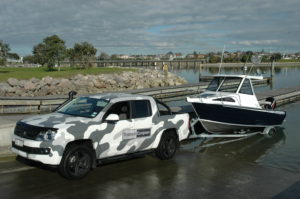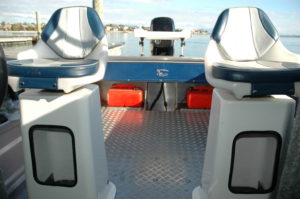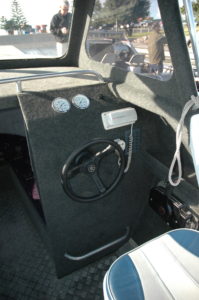The Scorpion 610 HT is the biggest selling boat in the expansive Scorpion range and has been designed unashamedly towards the fishing enthusiast.
As the hardtop evolution continues, so do the brands on offer and the choice is becoming harder and more complex for buyers. While in essence they are all designed for a similar purpose, every boat is different and each possesses some trait that either will or will not appeal to you. One company that has been building hardtops for many years and takes huge stock in customer feedback is Sportcraft Boats Ltd, manufacturer of the Scorpion brand.
Recently it released the new upgraded 610HT, an entry level hardtop that at just a few dollars over $40,000 for a complete package is extremely sharp buying. The 610 has proven a very successful hull for Scorpion and apart from the hardtop model is also available as a centre console and in various cabin versions. Jamie Black, MD of Sportcraft Boats Ltd, says that the 610HT was designed with specific criteria.

“First it had to have a 5mm hull to ensure softness of ride, a cabin with bunks long enough to sleep on, but still having a big working space in the cockpit. “We achieved the right balance between cabin and cockpit by putting on a small hardtop, which not only cuts down the windage while underway, but maximised cockpit fishing room while offering the protection expected from a hardtop”, says Jamie.
It was also important to be able to offer the boat with as little as 90hp, while still achieving adequate performance. To be honest I was quite surprised with the power choice. When I first saw the Scorpion 610HT, I thought I would find at least a 115hp or even a 140hp outboard on the transom. Not so. Here was a 2-stroke carburetted Mercury 90hp, which on first impression seemed a little small on horsepower for a boat of that size. Again, not so!
Engine Choice
Jamie pointed out that it’s partially due to the big displacement (1.38 litres) of the in-line 3-cylinder engine that gives it the required low down grunt to pick the 610HT up onto the plane. The 90hp, 1.5-litre OptiMax is even better and if you still want more power, then the OptiMax 115hp and 125hp are also suitable. Both are based on the same engine platform as the OptiMax 90hp, so you gain the extra horsepower without any extra weight. The OptiMax 90hp is 33kg heavier than the 90hp 2-stroke and also a few thousand dollars more expensive.

There are a few 610s that have been sold with the even larger 135hp OptiMax, which due to the extra weight changes the dynamics of the boat and so Jamie always recommends adding trim tabs, something he doesn’t feel necessary with the smaller engine packages.
However I don’t really think you need the extra horsepower, as the Scorpion 610 HT runs exceptionally well with the lower horsepower. On a mirror smooth Tauranga harbour the 610HT slipped easily onto the plane at around 2500 rpm, with a very low transition. From a standard start and the throttle pushed all the way forward, the acceleration was impressive for a boat of this size and with only 90hp.
“While we find that the 90hp engine is more than suitable for most people, we do recommend that if you are crossing bars or boating with, say there or four divers all the time, then a 115hp or even a 125hp outboard is a better choice to compensate for the extra weight”, said Jamie.
Top speed was a respectable 38 mph @ 5500 rpm and on the calm waters both in the harbour and outside where there was a long, low swell. I found in the open water the best cruise around 26mph @ 4500 rpm and there was still plenty in reserve if I needed to suddenly use more throttle. The three-blade 18” Vengeance propeller proved the perfect match for the 90hp 2-stroke.
Balanced Layout
The designers have certainly achieved what they wanted in providing a boat that offers a balanced layout between cabin comforts and a workable and efficient cockpit. Up front the twin 2m berths offer a genuine option for overnight accommodation and with an optional infill you end up with a very large double berth. There is good storage under the squabs, plenty of natural light from the overhead Maxwell hatch and a generous 1.27m sitting headroom.

“We get a lot of comments from clients that say the generous height in the cabin and the length of the squabs, yet still retaining a very big cockpit are some of the factors in their decision to buy the boat”, says Jamie.
The interior is fully lined ,with no hint of alloy anywhere, a cabin light is standard and the aft bulkheads provide both extra storage and access to the rear of the helm. You have the option of an electric or portable toilet under the centre squabs plus a privacy curtain.

Access through the forward hatch for anchoring is okay, but in a boat this size I would opt for a full windlass so you never have to leave the helm. While the standard boat comes with an open anchor locker, if you fit a windlass the whole bin can be sealed.
The hardtop, as already explained, was designed to maximise the cockpit fishing space, but still offering sun and all weather protection and on all counts it works well.
By not having it fully enclosed on the sides not only cuts down the windage but it also means you can fish from the driver’s seat. The long hardtop is the perfect place for the aerials and a built in rod rack. Toughened glass forward screens and a pre-mount means they are all ready to accept a wiper should you require one. I wouldn’t have a boat like this without one, preferably two!
The large flat helm offers space for up to a 12” MFD screen and all the instruments and switches you’d need in a boat this size. There is a large storage area forward, with a full-width alloy handrail offering some extra security for your passengers. I commented to Jamie that I would like to see an upstand to stop small items falling back into the cockpit, something that is now planned for all 610s in the future. On both sides there is a small shelf for your keys, phone and other accessories.

Twin Hi-Tech seats with upholstered cushions mounted on fibreglass bases are standard, but you do have the option of back-to-backs should you require more seating. “Most boats seem to have the twin swivelling forward bucket seats and a padded removable fish/esky bin, which gives you seating for four, but can be left at home if you want more fishing space”, says Jamie.
Flat Side Decks

Storage in the cockpit is limited to full-length side trays, with optional rod racks available and a transom shelf that also contains the battery. I particularly liked the wide, flat side decks, which is something that fishos will really appreciate.
While there is no fuel capacity under the treadplate floor as all the space is taken up with air buoyancy, there is room for a pair of 45L tote tanks under the transom deck. These take up no more floor space than the standard 25L tanks.
Naturally, being an alloy boat there is the option to change the design of the transom area with the addition of bait tanks and walkthough options. The standard boat doesn’t have any of that, apart from a good sized boarding platform either side of the outboard pod, convenient hand holds, plus a drop-down ladder. The outboard pod is a great place to hold the scallops or mussels until you get home, or you can use it as a berley bin.
It may be over 10 years since the Scorpion 610 first appeared, but the metamorphosis over that period has resulted in a much improved boat. The hull has been changed to a more pronounced gull-wing design with wider chines to improve stability and offer a softer and drier ride. The hardtop also has an all-new look.

The 610HT takes the design to a new level and is unquestionably a perfect package for any fisho looking for an extremely well priced, well finished and well proportioned entry level hardtop boat.




